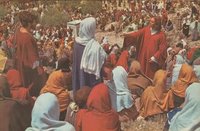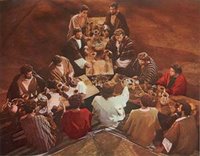 It's actually quite a while since I watched this film in full. Given this film is one of my top ten Jesus films this is perhaps something that needs addressing soon. Anyway, as a result this scene guide may have one or two omissions, although I think primarily it is extra-biblical material that is excluded. Scripture citations follow the normal format. FWIW, I reviewed this film back in March.
It's actually quite a while since I watched this film in full. Given this film is one of my top ten Jesus films this is perhaps something that needs addressing soon. Anyway, as a result this scene guide may have one or two omissions, although I think primarily it is extra-biblical material that is excluded. Scripture citations follow the normal format. FWIW, I reviewed this film back in March.[extra-biblical episode] - based on Josephus
Bethlehem - (Luke 1:26-38)
[extra-biblical episode]
Nativity - (Luke 2:1-7)
Wise Men - (Matt 2:1-12)
Death of the Infants - (Matt 2:13-16)
[extra-biblical episode]
John the Baptist - (Mark 1:2-8)
[extra-biblical episode]
Jesus' Baptism - (Mark 1:9-11)
Temptations - (Matt 4:1-11)
Calling of the Four - (Mark 1:16-20)
John and Herod - (Mark 6:18-20)
Various Miracles - (Mark 1:32-34)
Adulterous Woman - (John 8:2-11)
Deliverance of Madman - (Mark 1:23-28)
Death of John - (Mark 6:21-28)
[extra-biblical episode]
Sermon on the Mount - (Matt 5-7)Beatitudes - (Matt 5:2-12)
Calling/Training of 12 - (Mark 6:6-13)
Kingdom within you - (Luke 17:20-21)
Love your neighbour - (Mark 12:28-31)
Good Shepherd - (John 10:1-15)
Law & Prophets - (Matt 5:17-20)
Love Enemies - (Matt 5:43-48)
Sinners & Taxmen - (Mark 2:16-17)
Can't serve two masters - (Matt 6:24)
Consider the lilies - (Matt 6:25-30)
Weak & heavy laden - (Matt 11:28-30)
Lord's Prayer - (Matt 6:9-15)
Interval
Triumphal entry - (Mark 11:7-11a)
[extra-biblical episodes]
Last Supper - (Mark 14:16-25,27-31)
Gethsemane - (Mark 14:32-42)
Jesus's Arrest - (Mark 14:43-50)
Peter Denies Jesus – (Luke 22:54-62)
Sanhedrin Trial - (Mark 14:53-64)
Pilate 1st trial - (Luke 23:1-7)
Before Herod - (Luke 23:8-12)
Pilate 2nd trial - (Luke 23:13-25)
Road to the Cross – (Mark 15:20-22)
Crucifixion – (Mark 15:22-32)
Two Robbers on the cross - (Luke 23:39-43)
Jesus's Death - (Mark 15:33-41)
Appearance to Mary - (John 20:11-17)
Great Commission - (Matt 28:18-20)
A Few Notes
 This is one of the few films that actually shows how Jesus involved the disciples in spreading his message. The final scene before the interval is Jesus commissioning the twelve shortly after the Sermon on the Mount. It's an interesting juxtaposition of the two blocks of teaching which Matthew's gospel (the nearest literary parallel) separates by several chapters. In the film, it's as if Jesus is saying "this is the basic information for the masses, and now this is the real meat for my closest followers".
This is one of the few films that actually shows how Jesus involved the disciples in spreading his message. The final scene before the interval is Jesus commissioning the twelve shortly after the Sermon on the Mount. It's an interesting juxtaposition of the two blocks of teaching which Matthew's gospel (the nearest literary parallel) separates by several chapters. In the film, it's as if Jesus is saying "this is the basic information for the masses, and now this is the real meat for my closest followers". One of the most notable set design features of the film is the Y-shaped table at the Last Supper. It's an interesting prop which is surprisingly discussed. The initial decision facing the film-makers at this point is whether or not to mirror Leonardo's famous painting, as this is the definitive artistic image of the Last Supper. However, in most cases, where a Leonardo derived composition has been rejected, a more modern arrangement is taken with all the disciples around two or more sides of long tables. It's noticeable for example that Jesus films never show all the disciples eating at separate tables all within the same room, even though John's gospel happily accepts Jesus did not treat all his disciples equally (John 13:23-25). Almost without exception the disciples are pretty much treated equally. However, film-makers are also at pains to visually highlight the other-ness of Jesus, so, as far as I am aware, no film-maker has ever located the Lat Supper on round table as per King Arthur - in fact Jesus is always seated centrally, even though that is only assumption based on traditional Christian Art and the assumptions drawn from our culture.
One of the most notable set design features of the film is the Y-shaped table at the Last Supper. It's an interesting prop which is surprisingly discussed. The initial decision facing the film-makers at this point is whether or not to mirror Leonardo's famous painting, as this is the definitive artistic image of the Last Supper. However, in most cases, where a Leonardo derived composition has been rejected, a more modern arrangement is taken with all the disciples around two or more sides of long tables. It's noticeable for example that Jesus films never show all the disciples eating at separate tables all within the same room, even though John's gospel happily accepts Jesus did not treat all his disciples equally (John 13:23-25). Almost without exception the disciples are pretty much treated equally. However, film-makers are also at pains to visually highlight the other-ness of Jesus, so, as far as I am aware, no film-maker has ever located the Lat Supper on round table as per King Arthur - in fact Jesus is always seated centrally, even though that is only assumption based on traditional Christian Art and the assumptions drawn from our culture.Ray's Y shaped table is interesting then as maintains the centrality of Jesus, whilst being strikingly anti-Leonardo. Visually it is like three arrows all pointing to Jesus in the middle.
Whilst this book is part of the harmonising tradition, it is almost entirely based on the synoptics. Only three references from John feature in the entire 3 hours; The teaching about the good shepherd, the appearance to Mary Magdalene at the tomb, and the woman caught in adultery. Furthermore although this last episode is taken from John, it is excluded in many early texts of John, and included in some early texts of Luke.
 In "Reading the Gospels in the Dark", Richard Walsh devotes a chapter to this film comparing it to the Gospel of Luke. It's an interesting comparison, although I am not entirely convinced as the major point of comparison appears to its function. From the point of view of form, the centrality of the Sermon of the Mount is difficult to ascribe to any of the canonical gospels. The book's cover is based on an image of actor Jeffrey Hunter though.
In "Reading the Gospels in the Dark", Richard Walsh devotes a chapter to this film comparing it to the Gospel of Luke. It's an interesting comparison, although I am not entirely convinced as the major point of comparison appears to its function. From the point of view of form, the centrality of the Sermon of the Mount is difficult to ascribe to any of the canonical gospels. The book's cover is based on an image of actor Jeffrey Hunter though.Lastly, It is noticeable that Jesus spends so little time on screen. Peter Chattaway has done some serious analysis on this, which is reproduced in the second half of this post at the Arts and Faith discussion forum.
No comments:
Post a Comment